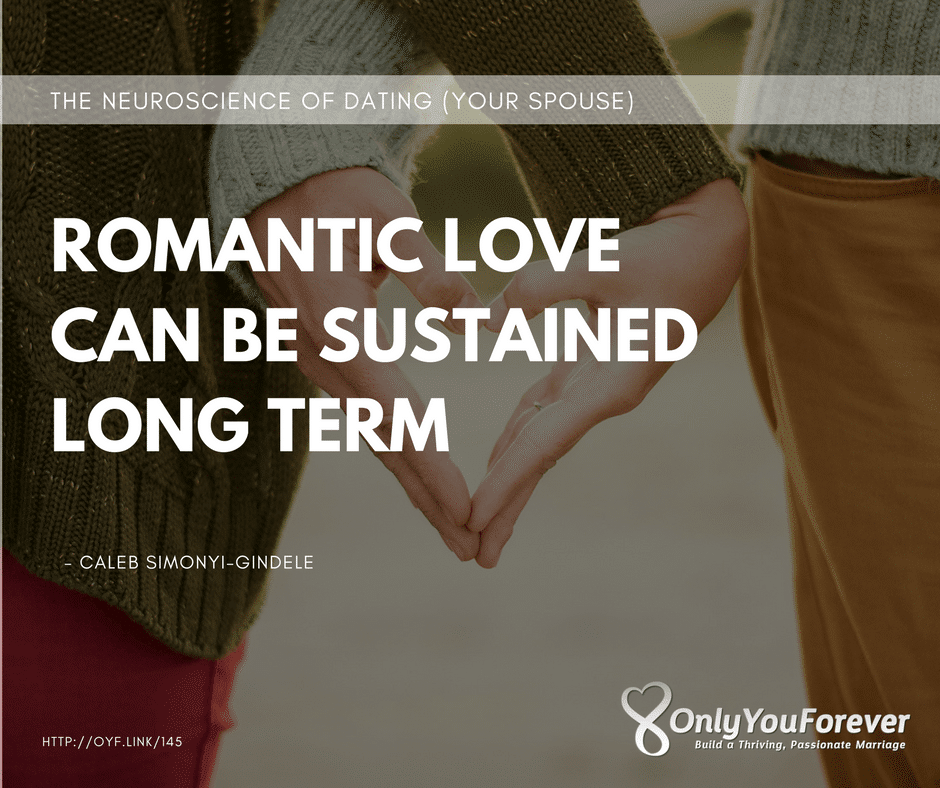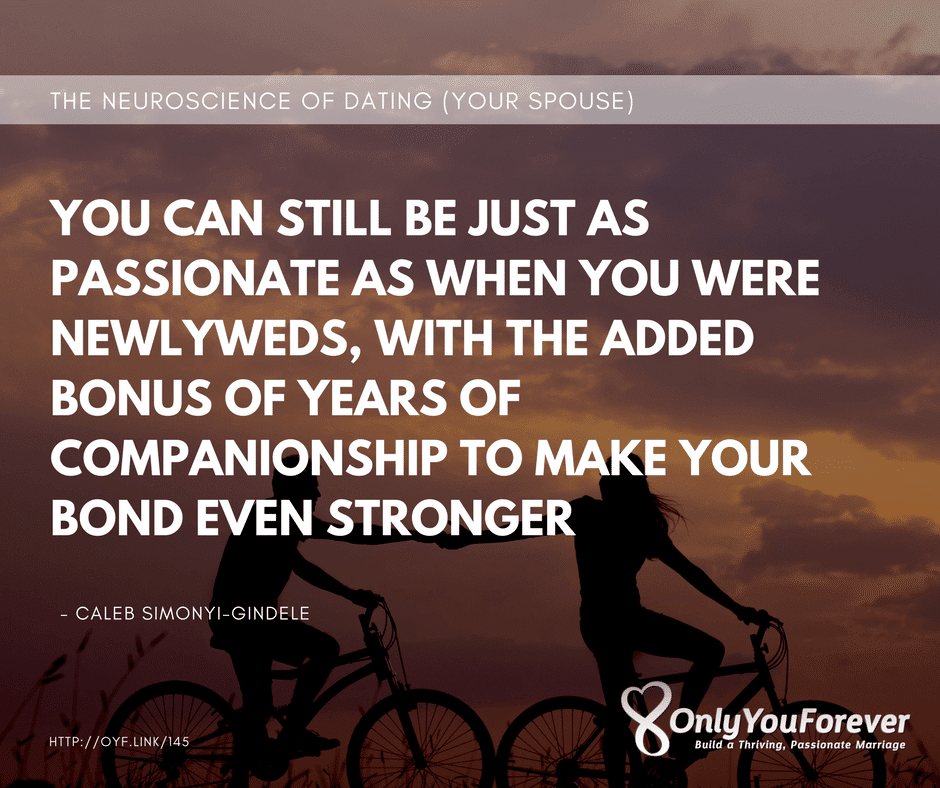Who knew your brain was doing so much when you were falling in love? Well, we want to help you fall in love again (or, more deeply) by helping you get those brain circuits working in support of keeping the romance in your marriage!
When most people talk about love over the course of a lifetime they say that it begins with a fiery, passionate love at the start of a relationship, which slowly dwindles to be replaced by a more stable, less exciting, companionate sort of love. This is actually mirrored in the different brain systems involved in love, but as we look through the research we’ll see that a loss in passion over time is far from inevitable.
The Neuroscience of Love & Relationships
There are 3 distinct brain systems involved in intimate relationships[i]:
-
- Sex drive
- Courtship attraction, aka romantic love
- Partner attachment
Each has a separate set of associated emotions, behaviours and brain systems. What we’re going to do is look at courtship attraction (or, romantic love) and then partner attachment. And then we’re going to look at the changes in romantic love over time to see if we can actually keep some of that heat going in marriage.
Romantic Love
Romantic love is observed in all cultures worldwide and can be felt even at a young age before puberty & sex drive develop[ii]. For example, your kindergarten teacher crush.
When you begin a romantic relationship as an adult, intensely romantic love typically lasts up to 18 months[iii], after which partner attachment becomes the main driving force of the relationship. One way to describe this is you have a lot of heat at the start of your relationship, then as you’re married and settle in for the long haul, your brain chemistry changes to support a steady burn which is more sustainable.
So romantic love, therefore, provides motivation to find a single long-term spouse, and attachment provides to motivation to stay together over the years. You need both.
Romantic Love in the Brain
How does romantic love affect the brain? A study by A. Aron from 2005[iv] used fMRI scans to monitor brain activity in 17 people who had been “intensely in love” for a short period of time (1-17 months) when looking at a photo of their beloved.
The areas of the brain that were activated were linked to the dopamine “reward system”, associated with pleasure (through the release of dopamine), general arousal, focused attention and motivation to pursue and acquire rewards. Romantic love is therefore considered a motivational force as well as just a feeling: you feel motivated to spend time together by the pleasure and arousal you experience. Think of love as driving the couple together with a very specific focus on one another.
As a sidebar: this system is separate from the sex drive, although they are correlated and often activated together since dopamine is also linked to sexual arousal. So, speaking from a Biblical values perspective you don’t need to have sex before marriage to really create a strong basis for marriage. By refraining from pre-marital sex you’re not taking anything away from the future of your marriage; contrary to the idea that you need to be sexually intimate before marriage as part of testing things out, research shows that the best sex happens inside marriage.
Higher levels of the neurotransmitter norepinephrine are also linked to feelings of love in that it creates a sense of alertness and attention as well as the increased heart rate, blushing and trembling often experienced in the early stages of love[v]. These bodily sensations are reflective of a ‘love storm’ going on in your brain!
And here’s another fascinating piece: the early stages of romantic love shows a similar brain pattern to obsessive-compulsive disorder: both show significantly higher levels of the serotonin transporter 5-HT. This is thought to produce the obsessive thoughts and tendency to place a very high value on a specific thing/person that is found in both romantic love and OCD. Levels of this transporter had returned to normal 12-18 months after the couples reported falling in love[vi]. So there may be some truth to sayings like “crazy for you” or “madly n love” after all.
Partner Attachment
What is partner attachment? It is “companionate love…a feeling of happy togetherness with someone whose life has become deeply entwined with yours[vii]“. This partner attachment or long-term love is neurologically distinct from romantic love but closely linked.
Attachment serves a different purpose than romantic love: where romantic love is about motivating you to form a highly intimate long-term bond with your partner, attachment kicks in once that bond is already formed and helps keep the relationship stable.
Attachment motivates long-term commitment and the sharing of work and parental duties and is characterized by shared interests, companionship, shared laughter and so on. What you’re not seeing here is infatuation or obsession, but something deeper and more abiding. Looking at it from the other side, forming this attachment is what causes such deep rending of the heart when a marriage breaks up. This is deep, powerful bonding. Not fireworks. More like lava.
And how did this work on the neurological side? A study in 2000 tested 17 men and women who had been in love for an average of 28 months, using the same measurements as in A. Aron [viii]’s study with newly in love couples. The brain activity in the couples who were together longer showed activation in the same areas relating to reward and motivation, although their feelings of love were described as being “less intense”.
These couples also showed brain activation in areas the others didn’t, such as systems involving the hormone oxytocin, which is linked to stronger bonds between couples. The expression of oxytocin is prompted by behaviors that affirm this bond.
So partner attachment is distinct from both romantic love and sex drive on a neural level, but again they are interlinked. Having sex stimulates the release of both dopamine and oxytocin, thereby reinforcing both romantic love and partner attachment.
The reason why I wanted to look at this is that we ourselves are in the stage of raising kids. We’re very busy with family and church activities and with OnlyYouForever. We’re thankful for a solid partner attachment. But I think the cautionary note is that it’s easy to think that romantic love is just puppy love. What we’re going to see after the break is that it is not necessary to have an either/or situation. What if you could have both? How awesome would that be?
To help you create this in your marriage we’ve created a plan to help you rekindle dating as a way to bring back the romantic love in your marriage.
Planning Your Next Date
Dating is such a fun, exciting time in a relationship, and settling up regular dates later in marriage can be a great way of rekindling that passion and adventure. Our guide will give you some inspiration on things to do, new ideas to try, and get you thinking about how you can start enjoying dating again, whatever stage of marriage you’re in.
Caleb after mid-roll: You’re listening to The Marriage Podcast for Smart People before the break we were talking about romantic love and partner attachment. These two systems. Now I’d like to talk about bringing that romantic love back online.
Changes in Romantic Love Over Time
It is a general perception across cultures that the initial romantic love declines over time, or that it is replaced with companionship and attachment. This is not just a North American construct. Here’s a quote from Nisa, a bushwoman from the Kalahari desert: “when two people are first together, their hearts are on fire and their passion is very great. After a while, the fire cools and that’s how it stays. They continue to love each other, but it’s in a different way- warm and dependable.[ix]“.
Research often supports this. A meta-review of studies measuring love found that an overall general sense of love is positively correlated with relationship length, but that passionate, obsessive love is negatively correlated with relationship length[x].
I don’t want to contradict myself here but rather point out there is the possibility of both-and rather than either-or. So it’s OK if you’re past the romantic love stage. You need a partner attachment. But what if you could have both?
You see, romantic love doesn’t always decrease over time. Some couples who had been married for an average of 21 years still reported feeling romantic love of the same intensity as newlyweds[xi]. These couples showed similar brain activity to the young couples when viewing pictures of their spouses (same procedure as Aron et al): same level of activation in the pleasure/reward areas of the brain.
Which is really cool. But the researcher noted that the older and younger couples weren’t using their brains exactly the same way.
While younger couples show brain activity linked to “mania, obsession, and anxiety”, the older couples showed higher levels of activation in brain areas controlling calmness. They also had increased activity in brain areas relating to attachment and partnership[xii]. So you can see the partner attachment is going strong and there is also a modulating factor around calmness.
Romantic love based on the pleasure/reward brain system can be sustained long term, but also benefits from the increased companionship of the attachment style of love. So you can have the best of both.
What is the benefit of having both? Well, high levels of brain activity for both romantic and attachment love were correlated with:
-
- Higher sexual frequency
- Increased friendship-based love
- Including your spouse in your sense of “self”
I think that’s really cool. So while romantic love has a tendency to decrease the longer into a relationship you go, the important thing is that it doesn’t have to. You can still feel just as passionate and lovey-dovey as you did when you were newlyweds, but with the added bonus of years of shared experiences and companionship to make your bond even stronger.
References:
[i] Helen E. Fisher, Arthur Aron, and Lucy L. Brown, ‘Romantic Love: A Mammalian Brain System for Mate Choice’, Philosophical Transactions: Biological Sciences, 361.1476 (2006), 2173–86.
[ii] Elaine Hatfield and others, ‘Passionate Love’, Journal of Psychology & Human Sexuality, 1 (1988), 35–51 <https://doi.org/10.1300/J056v01n01_04>.
[iii] Fisher, Aron, and Brown.
[iv] A. Aron, ‘Reward, Motivation, and Emotion Systems Associated With Early-Stage Intense Romantic Love’, Journal of Neurophysiology, 94.1 (2005), 327–37 <https://doi.org/10.1152/jn.00838.2004>.
[v] Fisher, Aron, and Brown.
[vi] D. Marazziti and others, ‘Alteration of the Platelet Serotonin Transporter in Romantic Love’, Psychological Medicine, 29.3 (1999), 741–45.
[vii] Hatfield and others.
[viii] Aron.
[ix] Fisher, Aron, and Brown.
[x] James M. Graham, ‘Measuring Love in Romantic Relationships: A Meta-Analysis’, Journal of Social and Personal Relationships, 28.6 (2011), 748–71 <https://doi.org/10.1177/0265407510389126>.
[xi] Bianca P. Acevedo and others, ‘Neural Correlates of Long-Term Intense Romantic Love’, Social Cognitive and Affective Neuroscience, 7.2 (2012), 145–59 <https://doi.org/10.1093/scan/nsq092>.
[xii] Acevedo and others.
Podcast: Play in new window | Download (Duration: 21:44 — 20.3MB)
